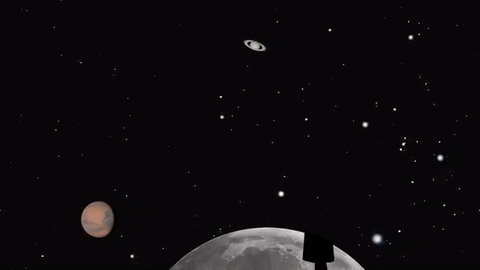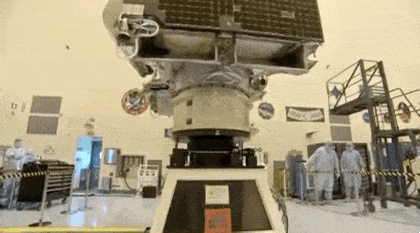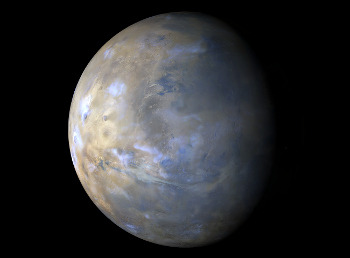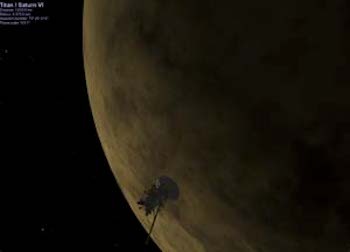What’s Up For June 2016?
What’s Up for June 2016?

What’s Up for June? Saturn at its best! Plus, good views of Mars, Jupiter and Jupiter’s moons continue from dusk to dawn.

You don’t have to stay up late to see Jupiter, Mars and Saturn this month, because they’re all visible soon after sunset. Jupiter is the brightest of the three, visible in the western sky all evening.

The four Galilean moons are easily visible in binoculars or telescopes. If you think you’re seeing 5 moons on June 10th, you’re not. One of them is a distant star in the constellation Leo.

For telescope viewers, the time near Mars’ closest approach to Earth, May 30th this year, is the best time to try to see the two moons of Mars: Phobos and Deimos. It takes patience, very steady skies and good charts! Mars is still large and bright in early June, but it fades as speedy Earth, in its shorter orbit around the sun, passes it.

Saturn has been close to Mars recently. This month Saturn reaches opposition, when Saturn, Earth and the sun are in a straight line with Earth in the middle, providing the best and closest views of the ringed beauty and several of its moons. You’ll be able to make out cloud bands on Saturn, in delicate shades of cream and butterscotch. They’re fainter than the bands of Jupiter. Through a telescope you’ll see Saturn’s rings tilted about as wide as they get: 26 degrees.

You’ll also have a ring-side view of the Cassini division, discovered by Giovanni Domenico Cassini, namesake of our Cassini spacecraft, orbiting Saturn since 2004 and continuing through September 2017. When you look at Saturn through a telescope, you can’t help but see several of its 4 brightest moons, and maybe more. If you just see one, that’s Titan, 50% larger than our own moon. A telescope can also reveal more moons, like Saturn’s two-colored moon Iapetus. It takes 3 months to orbit Saturn, and it’s fairly easy to see.

There’s a bright comet visible this month, Comet PanSTARRS. It’s best seen from the southern hemisphere, but it’s also visible from the U.S. low in the morning sky. Comet PanSTARRS can be seen through a telescope near the beautiful Helix Nebula on June 4, but it is visible all month.

Watch the full June “What’s Up” video for more: https://youtu.be/M7RtIa9zBYA
Make sure to follow us on Tumblr for your regular dose of space: http://nasa.tumblr.com
More Posts from Carlosalberthreis and Others
Infrared is Beautiful
Why was James Webb Space Telescope designed to observe infrared light? How can its images hope to compare to those taken by the (primarily) visible-light Hubble Space Telescope? The short answer is that Webb will absolutely capture beautiful images of the universe, even if it won’t see exactly what Hubble sees. (Spoiler: It will see a lot of things even better.)

The James Webb Space Telescope, or Webb, is our upcoming infrared space observatory, which will launch in 2019. It will spy the first luminous objects that formed in the universe and shed light on how galaxies evolve, how stars and planetary systems are born, and how life could form on other planets.
What is infrared light?
This may surprise you, but your remote control uses light waves just beyond the visible spectrum of light—infrared light waves—to change channels on your TV.
Infrared light shows us how hot things are. It can also show us how cold things are. But it all has to do with heat. Since the primary source of infrared radiation is heat or thermal radiation, any object that has a temperature radiates in the infrared. Even objects that we think of as being very cold, such as an ice cube, emit infrared.
There are legitimate scientific reasons for Webb to be an infrared telescope. There are things we want to know more about, and we need an infrared telescope to learn about them. Things like: stars and planets being born inside clouds of dust and gas; the very first stars and galaxies, which are so far away the light they emit has been stretched into the infrared; and the chemical fingerprints of elements and molecules in the atmospheres of exoplanets, some of which are only seen in the infrared.
In a star-forming region of space called the ‘Pillars of Creation,’ this is what we see with visible light:

And this is what we see with infrared light:

Infrared light can pierce through obscuring dust and gas and unveil a more unfamiliar view.
Webb will see some visible light: red and orange. But the truth is that even though Webb sees mostly infrared light, it will still take beautiful images. The beauty and quality of an astronomical image depends on two things: the sharpness of the image and the number of pixels in the camera. On both of these counts, Webb is very similar to, and in many ways better than, Hubble. Webb will take much sharper images than Hubble at infrared wavelengths, and Hubble has comparable resolution at the visible wavelengths that Webb can see.

Webb’s infrared data can be translated by computer into something our eyes can appreciate – in fact, this is what we do with Hubble data. The gorgeous images we see from Hubble don’t pop out of the telescope looking fully formed. To maximize the resolution of the images, Hubble takes multiple exposures through different color filters on its cameras.
The separate exposures, which look black and white, are assembled into a true color picture via image processing. Full color is important to image analysis of celestial objects. It can be used to highlight the glow of various elements in a nebula, or different stellar populations in a galaxy. It can also highlight interesting features of the object that might be overlooked in a black and white exposure, and so the images not only look beautiful but also contain a lot of useful scientific information about the structure, temperatures, and chemical makeup of a celestial object.
This image shows the sequences in the production of a Hubble image of nebula Messier 17:

Here’s another compelling argument for having telescopes that view the universe outside the spectrum of visible light – not everything in the universe emits visible light. There are many phenomena which can only be seen at certain wavelengths of light, for example, in the X-ray part of the spectrum, or in the ultraviolet. When we combine images taken at different wavelengths of light, we can get a better understanding of an object, because each wavelength can show us a different feature or facet of it.
Just like infrared data can be made into something meaningful to human eyes, so can each of the other wavelengths of light, even X-rays and gamma-rays.
Below is an image of the M82 galaxy created using X-ray data from the Chandra X-ray Observatory, infrared data from the Spitzer Space Telescope, and visible light data from Hubble. Also note how aesthetically pleasing the image is despite it not being just optical light:

Though Hubble sees primarily visible light, it can see some infrared. And despite not being optimized for it, and being much less powerful than Webb, it still produced this stunning image of the Horsehead Nebula.

It’s a big universe out there – more than our eyes can see. But with all the telescopes now at our disposal (as well as the new ones that will be coming online in the future), we are slowly building a more accurate picture. And it’s definitely a beautiful one. Just take a look…
…At this Spitzer infrared image of a shock wave in dust around the star Zeta Ophiuchi.

…this Spitzer image of the Helix Nebula, created using infrared data from the telescope and ultraviolet data from the Galaxy Evolution Explorer.

…this image of the “wing” of the Small Magellanic Cloud, created with infrared data from Spitzer and X-ray data from Chandra.

…the below image of the Milky Way’s galactic center, taken with our flying SOFIA telescope. It flies at more than 40,000 feet, putting it above 99% of the water vapor in Earth’s atmosphere– critical for observing infrared because water vapor blocks infrared light from reaching the ground. This infrared view reveals the ring of gas and dust around a supermassive black hole that can’t be seen with visible light.

…and this Hubble image of the Mystic Mountains in the Carina Nebula.

Learn more about the James Webb Space Telescope HERE, or follow the mission on Facebook, Twitter and Instagram.
Image Credits Eagle Nebula: NASA, ESA/Hubble and the Hubble Heritage Team Hubble Image Processing - Messier 17: NASA/STScI Galaxy M82 Composite Image: NASA, CXC, JHU, D.Strickland, JPL-Caltech, C. Engelbracht (University of Arizona), ESA, and The Hubble Heritage Team (STScI/AURA) Horsehead Nebula: NASA, ESA, and The Hubble Heritage Team (STScI/AURA) Zeta Ophiuchi: NASA/JPL-Caltech Helix Nebula: NASA/JPL-Caltech Wing of the Small Magellanic Cloud X-ray: NASA/CXC/Univ.Potsdam/L.Oskinova et al; Optical: NASA/STScI; Infrared: NASA/JPL-Caltech Milky Way Circumnuclear Ring: NASA/DLR/USRA/DSI/FORCAST Team/ Lau et al. 2013 Mystic Mountains in the Carina Nebula: NASA/ESA/M. Livio & Hubble 20th Anniversary Team (STScI)
Make sure to follow us on Tumblr for your regular dose of space: http://nasa.tumblr.com.
The Special Ingredients…of Earth!

With its blue skies, puffy white clouds, warm beaches and abundant life, planet Earth is a pretty special place. A quick survey of the solar system reveals nothing else like it. But how special is Earth, really?

One way to find out is to look for other worlds like ours elsewhere in the galaxy. Astronomers using our Kepler Space Telescope and other observatories have been doing just that!

In recent years they’ve been finding other planets increasingly similar to Earth, but still none that appear as hospitable as our home world. For those researchers, the search goes on.

Another group of researchers have taken on an entirely different approach. Instead of looking for Earth-like planets, they’ve been looking for Earth-like ingredients. Consider the following:

Our planet is rich in elements such as carbon, oxygen, iron, magnesium, silicon and sulfur…the stuff of rocks, air, oceans and life. Are these elements widespread elsewhere in the universe?

To find out, a team of astronomers led by the Japanese Aerospace Exploration Agency (JAXA), with our participation, used Suzaku. This Japanese X-ray satellite was used to survey a cluster of galaxies located in the direction of the constellation Virgo.

The Virgo cluster is a massive swarm of more than 2,000 galaxies, many similar in appearance to our own Milky Way, located about 54 million light years away. The space between the member galaxies is filled with a diffuse gas, so hot that it glows in X-rays. Instruments onboard Suzaku were able to look at that gas and determine which elements it’s made of.

Reporting their findings in the Astrophysical Journal Letters, they reported findings of iron, magnesium, silicon and sulfur throughout the Virgo galaxy cluster. The elemental ratios are constant throughout the entire volume of the cluster, and roughly consistent with the composition of the sun and most of the stars in our own galaxy.

When the Universe was born in the Big Bang 13.8 billon years ago, elements heavier than carbon were rare. These elements are present today, mainly because of supernova explosions.

Massive stars cook elements such as, carbon, oxygen, iron, magnesium, silicon and sulfur in their hot cores and then spew them far and wide when the stars explode.

According to the observations of Suzaku, the ingredients for making sun-like stars and Earth-like planets have been scattered far and wide by these explosions. Indeed, they appear to be widespread in the cosmos. The elements so important to life on Earth are available on average and in similar relative proportions throughout the bulk of the universe. In other words, the chemical requirements for life are common.

Earth is still special, but according to Suzaku, there might be other special places too. Suzaku recently completed its highly successful mission.
Make sure to follow us on Tumblr for your regular dose of space: http://nasa.tumblr.com


A cidade de Parintins está nos dias de festa religiosa, e então, resolvi relembrar a visita no local mais alto da torre da catedral, onde está localizado a estátua de Nossa Senhora do Carmo. #TorredaCatedraldeParintins Data de registro: 16 de julho de 2018 às 18h18

Os cientistas da missão New Horizons da NASA estão aprendendo cada vez mais sobre a estrutura e o comportamento da complexa atmosfera de Plutão, descobrindo novos atributos das suas extensas camadas de névoas. As névoas foram descobertas pela primeira vez quando a sonda New Horizons as fotografou em Julho de 2015.
Os cientistas da missão descobriram que as camadas na atmosfera de nitrogênio de Plutão, variam em brilho dependendo da iluminação e do ponto de vista, embora ela mantenha sua estrutura vertical geral. As variações de brilho podem ocorrer devido as ondas de flutuações, que os cientistas também chamam de ondas de gravidade (e que nada tem a ver com as ondas gravitacionais), que são normalmente lançadas pelo fluxo de ar sobre as cadeias de montanhas. As ondas de gravidade atmosféricas são conhecidas na Terra, em Marte, e agora, provavelmente em Plutão.
As camadas da atmosfera de Plutão são vistas da melhor forma em imagens que foram feitas pela sonda New Horizons quando ela passou atrás do planeta anão. A sonda New Horizons, obteve uma série de imagens retroiluminadas enquanto ela passou por Plutão, no dia 14 de Julho de 2015. Nessas observações feitas pelo instrumento Long Range Reconnaissance Imager, ou LORRI, as camadas atmosféricas sobre localizações específicas em Plutão foram imageadas algumas vezes, num intervalo de 2 a 5 horas. O brilho das camada variam de cerca de 30%, apesar da altura das camadas acima da superfície permanecer a mesma.
Plutão é simplesmente espetacular, quando as primeiras imagens da estrutura da atmosfera foram observadas, elas surpreenderam a todos. O fato de não se ter observado as camadas atmosféricas se movendo para cima e para baixo será importante para os esforços de modelagem no futuro.
Fonte:
https://www.nasa.gov/feature/pluto-s-haze-varies-in-brightness
Solar System: 5 Things To Know This Week

This month you can catch a rare sight in the pre-dawn sky: five planets at once! If you look to the south (or to the north if you’re in the southern hemisphere) between about 5:30 and 6 a.m. local time you’ll see Mercury, Venus, Saturn, Mars and Jupiter lined up like jewels on a necklace. They’re beautiful in the sky, and even more fascinating when you look closely.
This week we’re taking a tour of the planets with recent information about each:
1. Artistic License

Craters on Mercury are named for writers and artists of all kinds. There are Tolstoy, Thoreau and Tolkien craters, for example, as well as those that bear the names of the Brontës, photographer Dorothea Lange and dancer Margot Fonteyn. See the complete roster of crater names HERE.
2. Lifting the Veil of Venus

A thick covering of clouds made Venus a mystery for most of human history. In recent decades, though, a fleet of robotic spacecraft has helped us peer past the veil and learn more about this world that is so like the Earth in some ways — and in some ways it’s near opposite.
3. Curious?

Have you ever wanted to drive the Mars Curiosity rover? You can take the controls using our Experience Curiosity simulation. Command a virtual rover as you explore the terrain in Gale Crater, all using real data and images from Mars. Try it out HERE.
4. Now That’s a Super Storm

Winter weather often makes headlines on Earth — but on Jupiter there’s a storm large enough to swallow our entire planet several times over. It’s been raging for at least three hundred years! Learn about the Great Red Spot HERE.
5. Ring Watcher

This week, the Cassini spacecraft will be making high-resolution observations of Saturn’s entrancing rings. This is a simulated look at Saturn, along with actual photos of the rings from the Cassini mission.
Want to learn more? Read our full list of the 10 things to know this week about the solar system HERE.
Make sure to follow us on Tumblr for your regular dose of space: http://nasa.tumblr.com
Solar System: Things to Know This Week
Our solar system is huge, let us break it down for you. Here are a few things to know this week:
1. Juno Eyes on Jupiter

After a journey of more than five years, the Juno spacecraft is ready for its detailed look at Jupiter—arrival date: July 4. Using Eyes on the Solar System and data from the Juno flight team, you can take a virtual ride onboard the spacecraft in the “Eyes on Juno” simulation.
2. Taking a Spacecraft for a Spin

Preparations for the launch of the OSIRIS-REx asteroid mission are spinning up, literally. Here, the spacecraft can be seen rotating on a spin table during a weight and center of gravity verification test at our Kennedy Space Center. Liftoff is scheduled for Sept. 8. This spacecraft will travel to a near-Earth asteroid called Bennu and bring a small sample back to Earth for study.
3. Long-Range (Or at Least Long-Distance) Weather Report

Our Mars Reconnaissance Orbiter acquires a global view of the red planet and its weather every day. Last week, dust storms continued along the south polar ice cap edge. Northern portions of Sirenum, Solis, and Noachis also experienced some local dust-lifting activity. A large dust storm propagated eastward over the plains of Arcadia at the beginning of the week, but subsided just a few days later over Acidalia.
4. Hello from the Dark Side

The New Horizons spacecraft took this stunning image of Pluto only a few minutes after closest approach in July 2015, with the sun on the other side of Pluto. Sunlight filters through Pluto’s complex atmospheric haze layers. Looking back at Pluto with images like this gives New Horizons scientists information about Pluto’s hazes and surface properties that they can’t get from images taken on approach.
5. A Titanic Encounter

On June 7, our Cassini orbiter will fly very close by Saturn’s giant, haze-shrouded moon Titan. Among the targets of its observations will be the edge of the vortex that swirls in Titan’s thick atmosphere near its south pole.
Want to learn more? Read our full list of the 10 things to know this week about the solar system HERE.
Make sure to follow us on Tumblr for your regular dose of space: http://nasa.tumblr.com

❝Vou pintar o meu Brasil de azul e branco
Das cores da minha nação
Das cores do meu país
O azul do planeta do céu e do mar
Inspiração dos poetas
Que o próprio criador pintou
Veste a camisa azul e branca
Vem sentir a emoção
Sinta a magia que encanta
Do folclore do boi campeão❞
-
 spanishfly86 reblogged this · 7 years ago
spanishfly86 reblogged this · 7 years ago -
 spanishfly86 liked this · 7 years ago
spanishfly86 liked this · 7 years ago -
 bebino reblogged this · 7 years ago
bebino reblogged this · 7 years ago -
 predictivemarketing-blog liked this · 8 years ago
predictivemarketing-blog liked this · 8 years ago -
 saltyforyou liked this · 8 years ago
saltyforyou liked this · 8 years ago -
 starswhogaze-main reblogged this · 8 years ago
starswhogaze-main reblogged this · 8 years ago -
 the-odd-aardvadillo liked this · 8 years ago
the-odd-aardvadillo liked this · 8 years ago -
 diveintospace reblogged this · 8 years ago
diveintospace reblogged this · 8 years ago -
 fabrizioneedsfood reblogged this · 8 years ago
fabrizioneedsfood reblogged this · 8 years ago -
 your-buns-are-ready reblogged this · 8 years ago
your-buns-are-ready reblogged this · 8 years ago -
 your-buns-are-ready liked this · 8 years ago
your-buns-are-ready liked this · 8 years ago -
 ambidexedition liked this · 8 years ago
ambidexedition liked this · 8 years ago -
 jackfrostycoke liked this · 8 years ago
jackfrostycoke liked this · 8 years ago -
 nanda--monteiro liked this · 8 years ago
nanda--monteiro liked this · 8 years ago -
 doctorintrovert liked this · 8 years ago
doctorintrovert liked this · 8 years ago -
 peaches-n-screams liked this · 8 years ago
peaches-n-screams liked this · 8 years ago -
 fuckingell liked this · 8 years ago
fuckingell liked this · 8 years ago -
 yozoshimada liked this · 8 years ago
yozoshimada liked this · 8 years ago -
 unorigionaltaco liked this · 8 years ago
unorigionaltaco liked this · 8 years ago -
 lennykrskova-blog liked this · 8 years ago
lennykrskova-blog liked this · 8 years ago -
 fleurdebach5-blog liked this · 8 years ago
fleurdebach5-blog liked this · 8 years ago -
 swampygreenie reblogged this · 8 years ago
swampygreenie reblogged this · 8 years ago -
 gamingonethings liked this · 8 years ago
gamingonethings liked this · 8 years ago -
 alienamarcellus liked this · 8 years ago
alienamarcellus liked this · 8 years ago -
 lmaolewis liked this · 8 years ago
lmaolewis liked this · 8 years ago -
 lululuvs-blog1 reblogged this · 8 years ago
lululuvs-blog1 reblogged this · 8 years ago -
 cyberpilate reblogged this · 8 years ago
cyberpilate reblogged this · 8 years ago -
 swampygreenie liked this · 8 years ago
swampygreenie liked this · 8 years ago -
 ke-liyah15-blog liked this · 8 years ago
ke-liyah15-blog liked this · 8 years ago -
 boomshakerock reblogged this · 8 years ago
boomshakerock reblogged this · 8 years ago -
 livelaughflutter-blog liked this · 8 years ago
livelaughflutter-blog liked this · 8 years ago -
 poetcc-things liked this · 8 years ago
poetcc-things liked this · 8 years ago -
 pornogore-sapiens666-blog reblogged this · 8 years ago
pornogore-sapiens666-blog reblogged this · 8 years ago -
 alsharqawy liked this · 8 years ago
alsharqawy liked this · 8 years ago

